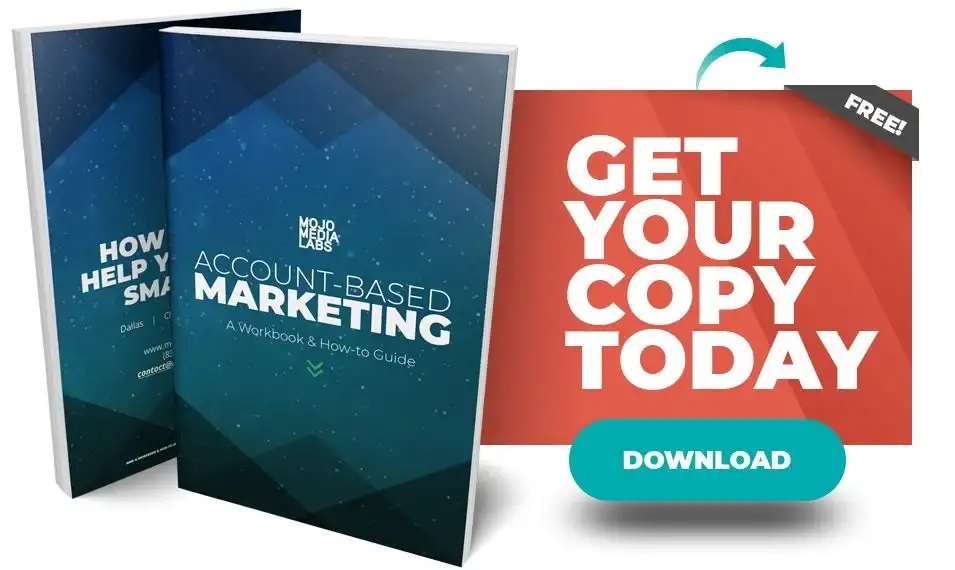How to Segment your Target Account List for Account-Based Marketing
You are looking to implement an account-based marketing (ABM) strategy. You have already created a target account list, but you aren't sure how to prioritize your list.
Whether you added every company in an industry you serve, or you created a list of 100 target accounts, this article will help you assess how to best prioritize your target account list.
Building Your Target Account List
We have previously written a blog titled How to Create and Use Your Target Account List for Account-Based Marketing. If you are looking for help building your list from scratch, go check out that blog, then come back to go more in-depth.
For a high-level overview, here's the quick checklist from that blog.
- Create an Ideal Customer Profile: Look at your current customers. Which ones do you love working with? Identify the trends between your favorite accounts. Write the trends down. You created an Ideal Customer Profile.
- Create a Target List based on your Ideal Customer Profile: Find more companies like the current companies you love working with.
- Understand the Accounts on the list: Assess how likely each account is to buy from you. Even though every company is a good fit, they probably aren't all likely to close quickly.
- Create a tiered approach: Now that you have assessed the likelihood of an account closing, focus your efforts on the accounts you see will close more quickly.
- Align your Team: You now have a detailed list of accounts you are targeting. Make sure everyone understands their responsibilities, then go close some deals.
This blog will provide a more in-depth look at understanding the accounts on the list and creating a tiered approach. It starts with assessing your current target account list.
What's the "Right" List Size?
While this is the most frequently asked question in the account-based marketing process, it does not have a clear answer. It would be great to be able to suggest a list size for companies based on any number of criteria, but your perfect-sized list must determine internally through collaborative meetings.
To create the right sized list, your marketing and sales teams should consider discussing:
- existing territories
- new territory suggestions
- sales team capacity
- marketing capacity
- close rates
- sales cycles
Discussing these details as they exist before ABM implementation helps you iterate in the long run and not bite off more than you can chew at any point in your ABM journey.
Consider capacity first, then grow with your ABM program as it increases business revenue and allows that growth to happen. The answer is subjective, but it's honestly for the best.
With that said, you will likely have a small list or a large list after internal discussion and filtering accounts through your ICP. Based on the size list you have, there are a few different options you have.
What Should You Do With A Small Target Account List?
Many marketers launching their first ABM campaign want to do it just right. These marketers stick exactly to the criteria they laid out in their ICP. They then find themselves left with an incredibly small list of target accounts.
If you have a small list, further segmentation may not be needed. By the nature of not having many accounts on the list in the first place, you are already focused.
If you have a small list for your first ABM campaign, there are a few things you can do.
- Use this list as your test group: A small list will work incredibly well if you are still working on getting buy-in from the entire team around ABM. You can continue to let your other marketing initiatives run while using some more personalized and targeted approaches on this small list of accounts. You can use this small list to prove the effectiveness of ABM and get complete buy-in from your team.
- Provide truly hyper-focused content: A small list is not bad. In many cases, a small list is a fantastic place to start when launching an ABM campaign. With so few accounts, you have more bandwidth to provide a one-to-one approach. You can assess what works, then start trying to scale your efforts from there. If you take this route, the accounts need to have an incredibly high likelihood of closing and need to have a large deal size.
- Rerun the list without one trait from your ICP: When you created this list, you likely used your ICP as the framework for what accounts you would target. If you don't have enough of a list to effectively get meaningful results, you need to rerun your list and broaden what you're looking for. The easiest way to do this is to remove the trait you find least important as an indicator of success. You can still use this smaller list potentially as your most high-value accounts.
- Start Over: If after you've looked at your ICP and you still have too small of a list, you may not have enough data to create an actionable target account list. You may need to start with the total accessible market and narrow down from there. Look at the following section to learn more.
How do you Segment a Large Target Account List?
If you fall into the gigantic list camp, you need to segment your lists into more manageable segments. You should create a tiered approach to ensure you prioritize well. Most experts will say a three-tiered approach works best.
Some incredibly practical ways you should consider segmenting your approach are:
- Moving from total accessible market to target accounts.
- Account Engagement
- Ease of Access
- Reputation
- Buyer Intent
Segmentation from Total Accessible Marketing to Target Accounts
If you have an incredibly large list, there is the potential you created a list including your Total Accessible Market (TAM). Your TAM is every company that could potentially use your product or service at some point.
TAM is a great place to start when assessing target accounts. With that said, your key target accounts should have made your target account list for more reasons than they might purchase at some point. These accounts will engage with you through content with little to no personalization—these engagements including ebook downloads, short meetings at tradeshows, and webinar attendance.
Your total accessible market should be aware of you but not targeted by you. For an easy starting point with your TAM, look at every company in your CRM.
Once you have established your TAM, you can further drill down into your Target Market. These accounts have more potential for long-term success. The Target Market accounts should fall in line with your ICP, but not all will show intent to buy. Target Market accounts will participate in the TAM-based engagement opportunities and also exist in nurture campaigns, segmented personalization such as content including basic personalization tokens or certification courses.
Consider this your tier three of your ABM strategy. They should know you for the problem you solve.
From the Target Market, you will determine Target Accounts. Your target accounts line up with your ICP and show buying intent. These accounts will receive targeted tactics that are high touch and specific to those accounts. These tactics include personalized advertisements, discounts to events like webinars or speaking engagements, and the previously mentioned target account tactics reliant on segmentation and nurture sequences.
These accounts are tier two in your ABM strategy. They should predominantly be engaging with your marketing materials and spending time on your website learning.
From the Target Accounts, you then decide which are the Priority Accounts. These accounts will receive more quality attention, resources, and budget than the previous segments. These accounts receive the highest, most personalized touch accounts outside of opportunities and customers already in your funnel.
The spend is higher to close Priority Accounts, but it will be worth it since these accounts are most likely to close with long-term, high-value contracts. The tactics for Top Accounts includes highly personalized messaging within advertisements, your website content, direct mail, and email, in addition to field activities.
These accounts are your tier one accounts and should know the name of a sales rep from your company.
Segmentation based on Account Engagement
ABM focuses on closing the best fit accounts that are more likely to have a long-term successful relationship with your company. Companies that are frequently engaging with your marketing content are more likely to be a good-fit account. They have shown significant interest and are worth exploring further.
Numerous platforms enable you to see if a company is looking at your marketing materials. If you are currently using a CRM, talk with your customer success representative to see what platforms they recommend.
Both HubSpot and Terminus have tools for tracking specific account engagement in their platforms.
Within HubSpot, under the contacts tab, there is an option for target accounts. Once you have opened the target accounts menu, you can select either recommendations or prospecting.
The recommendations tab will look at your CRM and recommend companies you may want to target.
The prospects tab will look at companies frequently engaging with your website. These companies can be easily added to your CRM and your target account lists.
Within Terminus, you also see what companies have been engaging with your marketing materials and a few other key insights. Terminus is an All-in-One ABM platform so that you will have a lot of incredibly actionable ABM insights.
With Terminus, you can filter your list based on the level of engagement within a predetermined time. You can export this list into a new static list.
Additionally, Terminus can seamlessly integrate with numerous CRM platforms so you can have engagement data directly in your CRM.
If you are looking for a robust ABM platform, consider partnering with Terminus. If you are looking for a comprehensive sales, marketing, and service platform to run your business, you should consider HubSpot.
Segment By Ease of Access
As mentioned above, ABM focuses on those accounts that are most easy to close. If an account has given you significant amounts of information to contact them, you will likely have an easier time making connections and closing deals.
The best way to access your ease of access would be to look at your CRM and identify the accounts that have the most associated contacts. If an account has numerous contacts associated with it, you will be able to launch an account-based marketing campaign to answer the potential questions of every decision-maker in the buying committee of a key account.
Within the HubSpot target account tool, you can filter by the number of contacts associated with the account. This simple filtering technique will allow your sales and marketing teams to craft a more effective account-based marketing strategy to engage the accounts with the most contact.
Using Terminus, you can see the number of associated contacts with each account. Additionally, Terminus looks at engagement levels between people in a target account and people in your organization. With this information, Terminus can determine who in your organization will be able to make the best introduction with this account.
The ABM technology is not necessary to start with ABM, but the right tools make implementing ABM immensely easier and more effective.
Segment By Reputation
If you are in a niche industry with a few players dominating the space, you may want to consider segmenting your efforts to focus on the most reputable and influential accounts.
Once you have secured these accounts, you can use the logos of these accounts in your marketing collateral and on your website. Additionally, you can create case studies on these accounts to show how you aided in their success.
These accounts will need highly targeted marketing messages and more attention than any other approach. They have found success already and likely have good relationships with their existing partners, so it will take time to prove the value you can bring them. But once you have identified a potential pain point they experience and that you can solve for, ensure you send marketing and sales messages that directly address this pain point.
As you look at the various accounts in an industry, ways you can identify the most successful are based on annual revenue, number of employees, and number of physical locations.
Additionally, you may want to consider looking at companies that have experienced massive growth over the past year. They may not be the industry leaders at this moment but could very likely become an industry leader. By targeting these accounts, you can develop a great relationship with the account as they continue to grow. They will attribute some of their success to your assistance, and then others will want to partner as well.
Segment by Buyer Intent
If you decide to develop an effective ABM strategy, you will eventually need to invest in the right ABM platforms.
Many of the ABM platforms can take your target account list and track all of their movements across the internet. These movements include when they start researching topics around your product offers, spending time on your website, or spending time on your competitor's website.
If a target account is researching information surrounding your offer, they are likely looking to buy soon. In that case, it's a race to the first call. Whatever company lands, the first call sets the expectations and becomes the company to beat. You can't afford to wait for the target account to discover you.
This level of buyer intent is only available with an ABM platform like Terminus. With Terminus, you can have buyer intent information integrated directly into your CRM, so your sales team doesn't even have to change their routine sale workflows.
With this buyer intent readily available, your sales team can get together on Monday morning to see who was researching topics around your solution over the weekend. With this information, a salesperson can batch 30 calls with target accounts they know are in the market for your solution. Even if all 30 went to voicemail, you can follow up each call with a personalized email that offers some valuable content around what they were researching.
Having access to buyer intent data will equip you to properly prioritize your list by the most likely to close accounts in a way no other method can. When you know exactly what account is researching your offer, you have actionable information to engage the right contact at the right time with the right message. With buyer intent data, more accounts will close, and revenue will increase.
Verify, Iterate, and Update Post-ABM Launch
Account-based marketing at its core is a scalable strategic approach to hitting business goals as one team. As you attempt to see which accounts are performing, constantly monitor your accounts to identify trends in the data you collect and adjust accordingly.
As you segment your lists, you may determine a part of your ICP you deemed important has no real bearing on a customer's success. You may find there are criteria that do have a significant influence on your success with customers.
As you see trends or notice changes in the accounts themselves, update your targeting criteria and the list.
Updates might seem tedious, but with consistent vigilance from your team to measure target account success, you will find a balance that creates measurable metrics and allows for change. ABM is a long-term investment, so changing the list immediately after implementation is not the best idea. You should assess implement minor changes after your first 60 days of running your ABM program.
Your Target Account List Will Grow With You
The target account list is a strategic, scalable, living thing within your ABM program that should grow alongside your account-based marketing successes. As you grow your average contract size, increase revenue, and improve pipeline velocity, you will see room for expanding your target account list.
Keeping your entire organization involved through task delegation and constant communication makes the process much easier as the time to iterate and update does come. Give your target account list time to perform based on the segmentation approach you chose, then look at the data to see what worked. From there, you will have a clear path towards further improvement.
Start Segmenting
After reading the blog, you have information on a few ways you can segment your first ABM target list. Based on the tools you have, determine the best segmentation tactic for you. If you'd like to discuss how to properly implement one of the ABM tools discussed above, please schedule a call today.

.png)

